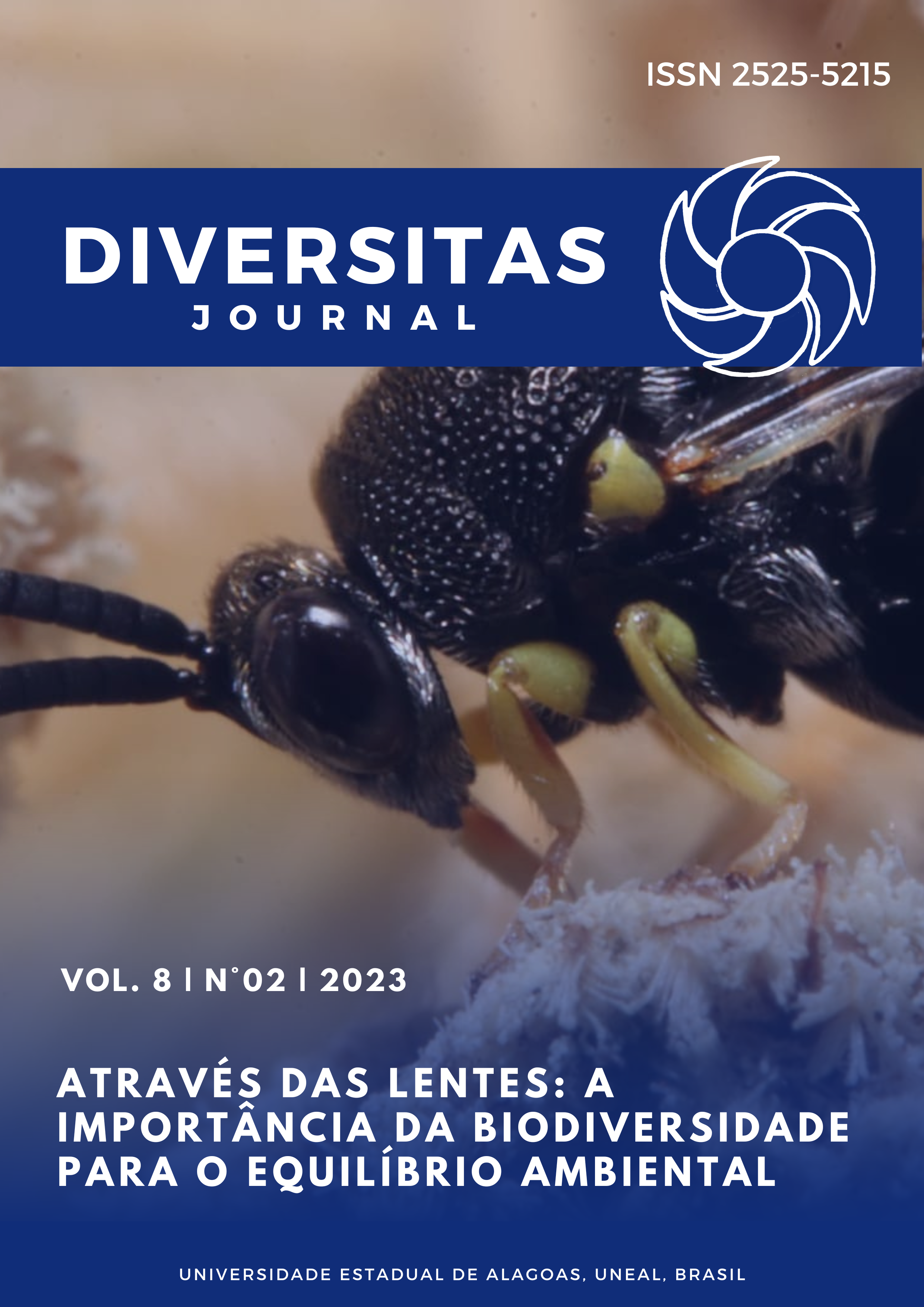Osmophore Patterns in Asarifolia Species (Desr.) Roem. & Schult. (Convolvulacea)
DOI:
https://doi.org/10.48017/dj.v8i2.2518Keywords:
Osmophoros, Floral Attractantes, PollinationAbstract
To achieve reproductive fitness, floral attractants are essential for insect-plant interaction. Many entomophilous pollination plants have odorous zones, composed of glands that release volatile odors, these odors act as attractants for potential pollinators. Ipomea Asalifoila flowers were used for this study. One of its main characteristics is its infundibuliform morphology and glabrous leaves, and its reproductive structures are located in the center of the flower. In order to better understand the dynamics of the release of these odors, Ipomea A. flowers were collected to perform the test in neutral red 60%, and photographed before, during and after the procedure. These flowers were enveloped and separated by day of anthesis, from the first to the third day, where floral death occurred. After the tests, variations in the days of anthesis of the flowers were observed, with a gradual effect. Besides an osmotic concentration in their reproductive organs.
Metrics
References
BLANCO, H. G. Catálogo das espécies de mato infestantes de áreas cultivadas no Brasil. Família das Campainhas (Convolvulaceae). Biológico. v.44, n.11 p. 259-278, 1978.
CHHITTKA, L.: THOMSON, J.D. Cognitive ecology of pollination. Cambridge: Cambridge University Paress, 2004. 344p.
DÁLITILLO, W.; MARQUES, E. C.; FALCAO, C.F.; MOREIRA, D. D. O. Interações mutualísticas entre formigas e plantas. Entomobrasilis, vassouras, v.2 , n.2, pp 32-36, mai-ago. 2009.
DUDAVERA, N.; PICHERSKY, E. (2006.). Biology of floral scent. (1°ed.) Boca raton.
KIILL, L.H.P; RANGA, N.T. Ecologia da polinização de Ipomoea asarifolia (Ders.) Roem. & Schult. (Convolvulaceae) na região semi-árida de Pernambuco. Acta Botanica Brasilica. v.17, n.3 p.355-362, 2003.
MARINHO, C. R.; MARTUCCI, M. E. P.; GOBBO-NETO, L.; TEIXEIRA, S. P. (2018, maio) Chemical composition and secretion biology of the floral bouquet in legume trees (Fabaceae). Botanical Journal of the Linnean Society, v. 20, n. 1, p. 1-21. https://doi.org/10.1093/botlinnean/ boy002
MONTEIRO, E. A. S. (2010) Avaliação toxicológica da Ipomoea asarifolia (salsa) em ratos. Tese (doutorado) - Universidade Estadual Paulista, Faculdade de Ciências Agrárias e Veterinárias, 2010. Repositório Institucional UNESP. http://hdl.handle.net/11449/101236.
PLACHNO, B. J.; STPICZYNSKA, M.; DAVIES, K. L.; SWIATEK, P.; MIRANDA, V. F. O. Floral ultrastructure of two Brazilian aquatic-epiphytic bladderworts: Utricularia cornigera Studnička and U. nelumbifolia Gardner (Lentibulariaceae). Protoplasma, v. 254, n. 1, p. 353- 366, mar. 2016.
PANSARIN, E. R. (2003, jun) Biologia reprodutiva e polinização em Epidendrum paniculatum Ruiz & Pavon (Orchidacacae). Revista brasileira de botânica, v. 26, n 2 p. 203-211.
RAGUSO, R A.: PICHERSKY, E. A day in the life of a linalool molecule: Chemical communication in a plant-polinator system. Part 1 : Linalool biosynthesis in flowering plants. Plant Species Biology, v. 14, p. 95-120, 1999.
RECH, A R.: AGOSTINI, K.: OLIVEIRA, P. O.:MACHADO, I.C, Biologia da polinização. 1. Ed. Rio de janeiro: editora projeto cultural, 2014. 524p.
SPENGEL, Christian Konrad. (1793). Das entdeckte Geheimniss der Natur im Bau und in der Befruchtung der Blumen / (v 2). Bei Friedrich Vieweg dem æltern. Retrieved from https://doi.org/10.5962/bhl.title.61000
SAZIMA, M.; VOGEL, S.; COCUCCI, A. HAUSNER, G. The perfume flowers of Cyphomandra (Solanaceae): pollination by euglossine bees, bellows mechanism, osmophores and volatiles. Plant Systematics and Evolution, Austria, v. 187, n. 1, p. 51-88, 1993.
VOGEL S. (1963). Duftdrüsen im dienste der bestäubung : über bau und funktion der osmophoren. (2° Ed.). Akademie der Wissenschaften und der Literatur ; In Kommission bei F. Steiner.
WERYSZKO-CHMIELEWSKA, E.; STPICZYNSKA, M. Osmophores of Amorphophallus rivieri Durieu (Araceae). Acta Societatis Botanicorum Poloniae, Lublin, v. 64, n. 2, p. 121-129, 1995.
WIEMER, AP MORÉ, M BENITEZ-VIEYRA, S COCUICCI, AA RAGUSO, RA & SÉRSIC, NA. A simple floral fragance and unusual osmphore structure in cuclopogan elatus (Orchidacacae). Plant biology v.11, n.4. p.506-514. 2009. https://doi.org/10.1111/j.1438-8677.2008.00140.x
Downloads
Published
How to Cite
Issue
Section
License
Copyright (c) 2023 Adenaely Rodrigues da Rocha, José Valdemilson dos Santos Silva, Lucas Marcos Amorim da Silva, Maria do Carmo Carneiro, Jhonatan Ferreira da Silva, Camila Chagas Correia

This work is licensed under a Creative Commons Attribution 4.0 International License.
The Diversitas Journal expresses that the articles are the sole responsibility of the Authors, who are familiar with Brazilian and international legislation.
Articles are peer-reviewed and care should be taken to warn of the possible incidence of plagiarism. However, plagiarism is an indisputable action by the authors.
The violation of copyright is a crime, provided for in article 184 of the Brazilian Penal Code: “Art. 184 Violating copyright and related rights: Penalty - detention, from 3 (three) months to 1 (one) year, or fine. § 1 If the violation consists of total or partial reproduction, for the purpose of direct or indirect profit, by any means or process, of intellectual work, interpretation, performance or phonogram, without the express authorization of the author, the performer, the producer , as the case may be, or whoever represents them: Penalty - imprisonment, from 2 (two) to 4 (four) years, and a fine. ”


















